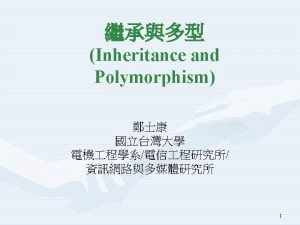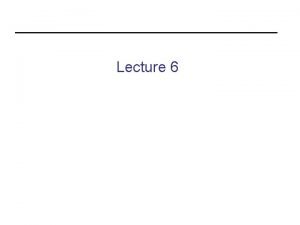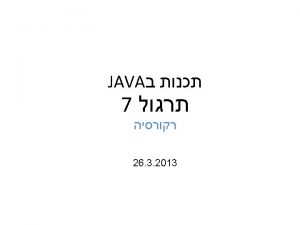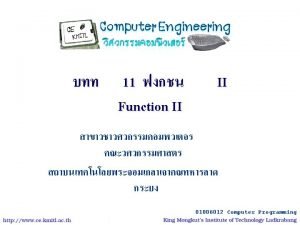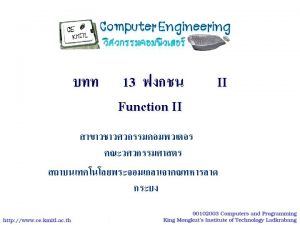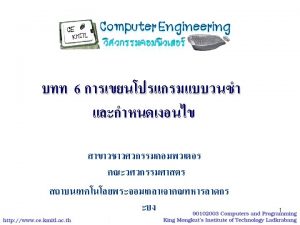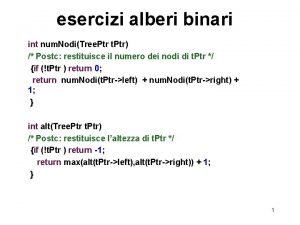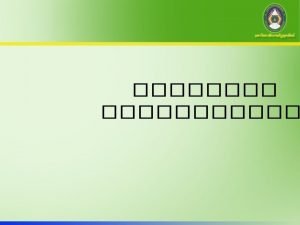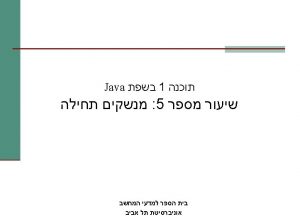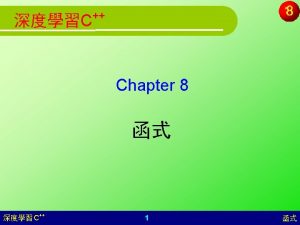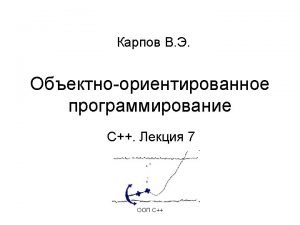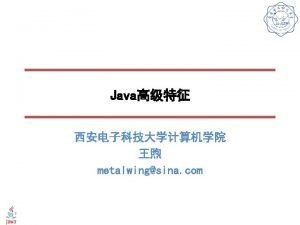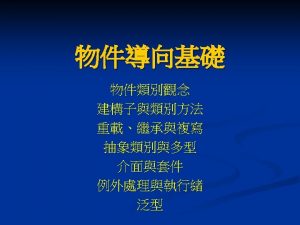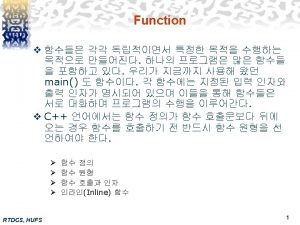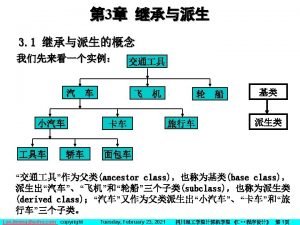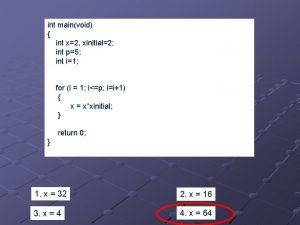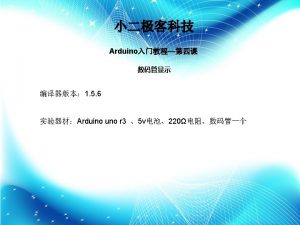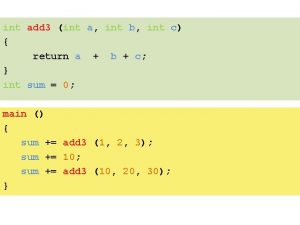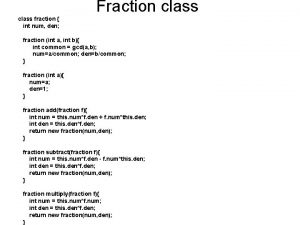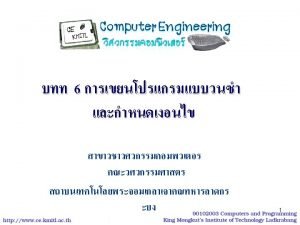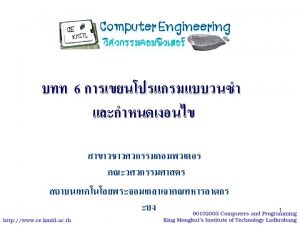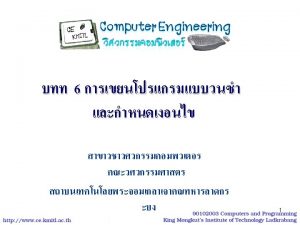class Car private long engine Num private int














![public class Inherit. Test { public Inherit. Test() { } public static void main(String[] public class Inherit. Test { public Inherit. Test() { } public static void main(String[]](https://slidetodoc.com/presentation_image/2ea38baa6be45d6d840cd6c77bc8b5cd/image-15.jpg)




![public class Polymorphism. Test { public Polymorphism. Test() { } public static void main(String[] public class Polymorphism. Test { public Polymorphism. Test() { } public static void main(String[]](https://slidetodoc.com/presentation_image/2ea38baa6be45d6d840cd6c77bc8b5cd/image-20.jpg)





















![n 建立主程式如下 //物件主程式 public static void main(String[] args) { //宣告List抽象類別,只允許輸入字串String資料 //抽象類別必須透過實體類別實體化,在此例如Array. List, Linked. List, n 建立主程式如下 //物件主程式 public static void main(String[] args) { //宣告List抽象類別,只允許輸入字串String資料 //抽象類別必須透過實體類別實體化,在此例如Array. List, Linked. List,](https://slidetodoc.com/presentation_image/2ea38baa6be45d6d840cd6c77bc8b5cd/image-42.jpg)


- Slides: 44






class Car { // 定義類別內在成員資料 private long engine. Num ; private int color ; final private String[] colorname = {"White", "Red", "Orange", "Yellow", "Green", "Cyan", "Purple", "Black"} ; private String model ; private double mileage ; private String brand ; // 不需要傳入引數的建構子 public Car() { } // 需要傳入引數的建構子 public Car(int engine. Num, int color, String model, int miles, String brand) { // 利用this賦予和引數同名的內在成員資料初始值 this. engine. Num = engine. Num ; this. color = color ; this. model = model ; this. mileage = miles ; this. brand = brand ; }

// 實例方法:設定引擎號碼 public void set. Engine. Num(long num) { engine. Num = num ; } // 實例方法:設定車款 public void set. Model(String id) { model = id ; } // 實例方法:設定車殼顏色代碼 public void set. Color(int color) { this. color = color ; } // 實例方法:設定里程數 public void set. Mileage(double miles) { mileage = miles ; } // 實例方法:設定製造商 public void set. Brand(String name) { brand = name ; } // 實例方法:取得引擎號碼 public long get. Engine. Num() { return engine. Num; } // 實例方法:取得顏色代碼及名稱 public int get. Color() { return color; } public String get. Color. Name() { return colorname[color] ; } // 實例方法:取得車型款式 public String get. Model() { return model; } // 實例方法:取得里程數 public double get. Mileage() { return mileage; } // 實例方法:取得製造商 public String get. Brand() { return brand; }

// 類別方法:傳回出產國 public static String get. Nation() { String nation = "Made in Japan" ; return nation ; } // 實例方法:列印二手車資訊 public void print. Vehicle() { System. out. println("The Manufactor is " + get. Brand()) ; System. out. println("The Model is " + model) ; System. out. println("Color Number is " + color) ; System. out. println("Color Name is " + colorname[color]) ; System. out. println("Engine Number is " + get. Engine. Num()) ; System. out. println("Mileage is " + mileage) ; } }

import static java. lang. System. * ; public class Class. Test { public static void main(String[] args) { System. out. println(Car. get. Nation()) ; // 取得靜態類別方法 // 宣告類別物件並傳入資料 Car car = new Car(82250080, 3, "Wish", 75008, "Toyota") ; car. print. Vehicle() ; // 取得二手車資訊 // 設定新的資訊 car. set. Brand("Honda") ; car. set. Model("Accord") ; car. set. Mileage(59225) ; car. set. Engine. Num(72320415) ; car. set. Color(0) ; // 取得靜態類別資訊 – 不需宣告類別物件 System. out. println(Car. get. Nation()) ; car. print. Vehicle() ; // 取得新的二手資訊 // 定義新的類別物件 Car suv = new Car() ; suv. set. Brand("Nissan") ; suv. set. Model("X-Trail") ; out. println(suv. get. Nation()) ; // 以類別物件取得靜態類別方法資訊 suv. print. Vehicle() ; } }


// 類別部份 // 測試主程式部份 class Mean. Value { public class Overload. Test { public Mean. Value() { public static void main(String[] args) { } Mean. Value mv = new Mean. Value() ; public double mean(double a, double b) { double a = 1. 5, b = 2. 3 ; double c = Math. sqrt(a*a + b*b) ; double[] c = {1. 1, 2. 2, 3. 3, 4. 4, 5. 5} ; return c ; double[] d = {6. 6, 7. 7, 8. 8, 9. 9, 11. 11} ; } System. out. println(mv. mean(a, b)) ; public double mean(double[] a) { System. out. println(mv. mean(c)) ; double c = 0. 0 ; System. out. println(mv. mean(c, d)) ; for(int i=0; i<a. length; i++) { } c = c + a[i]*a[i] ; } } return Math. sqrt(c) ; 類別中計算均值的三個Method } 具有相同之名稱mean, public int mean(double[] a, double[] b) { 其宣告之資料型態不盡相同, double c = 0. 0 ; 有int,也有double; for(int i=0; i<a. length; i++) { 且輸入的引數也都不一樣, c = c + a[i]*b[i] ; 有純量,也有陣列。 } 三個Method分別做不一樣的運算, return (int)Math. sqrt(c) ; 且傳回不一樣的值。 } }



class Sedan extends Car {// 繼承前述範例中之Car類別 private int door ; private double price ; public Sedan() { } public Sedan(int engine. Num, int color, String model, int miles, String brand) { super(engine. Num, color, model, miles, brand) ; // 呼叫父類別之建構子 } public void set. Door(int door) {// Number of doors this. door = door ; } public void set. Price(double price) {{// Price of the sedan this. price = price ; } public void print. Sedan() {// 印出父類別提供方法之資料及子類別之變數 System. out. println("The Manufactor is " + super. get. Brand()) ; System. out. println("The Model is " + super. get. Model()) ; System. out. println("Color Number is " + super. get. Color()) ; System. out. println("Color Name is " + super. get. Color. Name()) ; System. out. println("Engine Number is " + super. get. Engine. Num()) ; System. out. println("Mileage is " + super. get. Mileage()) ; System. out. println("The number of doors: " + door) ; System. out. println("The price is " + price) ; } }
![public class Inherit Test public Inherit Test public static void mainString public class Inherit. Test { public Inherit. Test() { } public static void main(String[]](https://slidetodoc.com/presentation_image/2ea38baa6be45d6d840cd6c77bc8b5cd/image-15.jpg)
public class Inherit. Test { public Inherit. Test() { } public static void main(String[] args) { // TODO code application logic here // 取得父類別之靜態類別方法 System. out. println(Car. get. Nation()) ; // 宣告類別物件並傳入資料 Sedan car = new Sedan(82250080, 3, "Wish", 75008, "Toyota") ; car. print. Vehicle() ; // 利用子類別繼承父類別二手車資訊並印出 // 定義新的子類別物件 Sedan suv = new Sedan() ; suv. set. Brand(“Nissan”) ; // 輸入子類別所繼承之父類別變數資料 suv. set. Model("X-Trail") ; suv. set. Mileage(59225) ; suv. set. Engine. Num(72320415) ; suv. set. Color(0) ; System. out. println(suv. get. Nation()) ; // 取得父類別之靜態類別方法資訊 suv. set. Door(4) ; // 輸入子類別變數資料 suv. set. Price(75000) ; suv. print. Sedan() ; } }


n 以繼承Car父類別的Sedan子類別中複寫Car類別的 set. Color方法為例,取得color代碼定義新的color字串 // Car類別中的set. Color方法 public void set. Color(int color) { this. color = color ; } public int get. Color() { return color; } // Sedan類別中的set. Color方法 public void set. Color(int color) {// Override super. set. Color(color) ; switch(super. get. Color()) { case 1: this. color = "red" ; break ; case 2: this. color = "black" ; break ; case 3: this. color = "green" ; break ; case 4: this. color = "blue" ; break ; case 5: this. color = "silver" ; break ; case 6: this. color = "golden" ; break ; default: this. color = "white" ; } } public String get. Colorname() { return this. color ; }


![public class Polymorphism Test public Polymorphism Test public static void mainString public class Polymorphism. Test { public Polymorphism. Test() { } public static void main(String[]](https://slidetodoc.com/presentation_image/2ea38baa6be45d6d840cd6c77bc8b5cd/image-20.jpg)
public class Polymorphism. Test { public Polymorphism. Test() { } public static void main(String[] args) { Shape s; // 抽象類別的物件變數 // 宣告類別型態的變數, 並且建立物件 Circle s 1 = new Circle(5. 0, 10. 0, 4. 0); Rectangle s 2 = new Rectangle(10. 0, 20. 0); Triangle s 3 = new Triangle(10. 0, 5. 0, 25. 0, 5. 0); // 呼叫抽象類型物件的抽象方法area() s = s 1; // 圓形 System. out. println("圓面積" + s. area()); // 相當於執行 Circle. area() ; s = s 2; // 長方形 System. out. println("長方形面積" + s. area()); // 相當於執行 Rectangle. area() s= s 3; // 三角形 System. out. println("三角形面積" + s. area()); // 相當於執行 Triangle. area() } }

// Shape抽象類別宣告 abstract class Shape { public double x; // 成員資料:X座標 public double y; // 成員資料:y座標 // 抽象方法: 計算面積 abstract double area(); } // Circle類別宣告 class Circle extends Shape { private double r; //成員資料:半徑 //建構子 public Circle(double x, double y, double r){ this. x = x; this. y = y; this. r = r; } // 成員方法: 實作抽象方法area() public double area() { return 3. 1416*r*r ; } }

class Rectangle extends Shape {// Rectangle類別宣告 private double x 1; //成員資料:X座標 private double y 1; //成員資料:Y座標 public Rectangle(double x, double y, double x 1, double y 1) { // 建構子 this. x = x; this. y = y; this. x 1 = x 1; this. y 1 = y 1; } public double area() { // 成員方法: 實作抽象方法area() return (y 1 -y)*(x 1 -x) ; } }

class Triangle extends Shape {// Triangle類別宣告 private double x 1; // X座標 private double y 1; // Y座標 private double l; // 三角形底長 public Triangle(double x, double y, double x 1, double y 1, double l) { // 建構子 this. x = x; this. y = y; this. x 1 = x 1; this. y 1 = y 1; this. l = l; } public double area() { // 成員方法: 實作抽象方法area() return (y 1 -y)*l/2. 0 ; } }


實作介面 class 類別名稱 implements 介面名稱 1, 介面名稱 2, … { … // 實作介面的方法 } n 繼承介面 interface 介面名稱 extends 繼承的介面 1, 繼承的介面 2 <<abstract>> <<interface>> { Shape Area. Interface … // 額外的常數和方法 +x: double +y: double PI: doube = 3. 14159 } area() n 右圖例中, n n n Circle類別繼承Shape抽象類別 並實作Shape. Interface介面 Circle Shape. Interface介面 -r: double 繼承Area. Interface介面 +area() <<interface>> Shape. Interface +perimeter()

public class Abstract. Interface. Test { public Abstract. Interface. Test() { } public static void main(String[] args) { // 宣告Circle類別型態的變數, 並且建立物件 Circle c = new Circle(10. 0, 7. 0, 5. 5); // 顯示介面的常數值 System. out. println("利用類別方法顯示相關參數") ; c. show() ; System. out. println("利用介面取得PI常數: " + Shape. Interface. PI); System. out. println("利用物件變數取得圓周率: " + c. PI) ; System. out. println("圓半徑: " + c. get. R()) ; System. out. println("圓心: (" + c. x + " , " + c. y + ")") ; // 呼叫物件的介面方法area() System. out. println("圓面積: " + c. area()) ; // 呼叫物件的介面方法perimeter() System. out. println("圓周長: " + c. perimeter()) ; } }

// Shape抽象類別宣告 abstract class Shape { public double x; // X座標 public double y; // Y座標 } interface Area. Interface { // Area. Interface介面宣告 double area(); // 介面方法: 計算面積 } interface Circum. Interface { // Circum. Interface介面宣告 double perimeter(); // 介面方法: 計算周長 } // Shape. Interface介面宣告, 繼承Area. Interface與Circum. Interface interface Shape. Interface extends Area. Interface, Circum. Interface { final double PI = 3. 1415926; // 常數的宣告 void show(); // 介面方法: 印出相關參數 }

// Circle類別宣告 class Circle extends Shape implements Shape. Interface { private double r; // 成員資料:半徑 // 建構子 public Circle(double x, double y, double r) { this. x = x; this. y = y; this. r = r; } // 實作Shape. Interface所繼承之 // 實作Shape. Interface中的show方法 // Area. Interface介面的方法area() public void show() { public double area() { System. out. println("PI=" + this. PI) ; return this. PI * this. r ; System. out. println("r=" + this. r) ; } System. out. println("x=" + this. x) ; // 實作Shape. Interface所繼承之 System. out. println("y=" + this. y) ; // Circum. Interface介面的方法perimeter() } public double perimeter() { // 利用get. R()方法傳回私有變數r的值 return 2. 0 * this. PI * this. r ; public double get. R() { } return r ; } }



Runnable介面 n 以下程式利用兩個執行緒累計執行停滯時間 package Threads. Demo; public class Runnable. Test { //主程式: 呼叫Sum. Class� 動執行緒 public static void main(String[] args) { System. out. print("執行緒: "); //輸出目前執行緒物件 System. out. println(Thread. current. Thread()); //建立執行緒物件 //定義執行緒 1 Sum. Runner st 1 = new Sum. Runner(15, 1); Thread t 1 = new Thread(st 1, "執行緒A"); Sum. Runner st 2 = new Sum. Runner(20, 2); //定義執行緒 2 Thread t 2 = new Thread(st 2, "執行緒B"); //� 動執行緒 t 1. start(); t 2. start(); } } class Sum. Class { private long length = 100; //進行加總延遲時間的迴圈 數(預設為 100) //建構子: 宣告時輸入要執行加總的迴圈數 public Sum. Class(long length) { this. length = length; } public long sum(int thread. ID) { long temp = 0; //停滯時間總和 for(int i=1; i<=length; i++) { int sleepduration = (int)(Math. random()*10); //隨 機� 生停滯時間 try {//Stop running for a short moment Thread. sleep(sleepduration); //時間暫停 } catch (Exception e) {} temp += sleepduration; System. out. println(thread. ID + ": " + i); //印出迴圈 數(因� 動執行緒平行運算, 執行緒代號會交互被輸出) } return temp; } }

// 繼承計算方法類別Sum. Class並實作Runnable介面的run()方法 class Sum. Runner extends Sum. Class implements Runnable { private int thread. ID; //建構子: 繼承Sum. Class中的成員變數(length) public Sum. Runner(long length, int thread. ID) { super(length); this. thread. ID = thread. ID; } //實作執行緒方法 public void run() { System. out. println(Thread. current. Thread() + "延遲時間總和 = " + sum(this. thread. ID) + "毫秒"); } } /*********執行結果********/ 執行緒: Thread[main, 5, main] 2: 1 1: 2 2: 2 : 1: 14 2: 17 1: 15 Thread[執行緒A, 5, main]延遲時間總和 = 77毫秒 2: 18 2: 19 2: 20 Thread[執行緒B, 5, main]延遲時間總和 = 84毫秒

Thread類別 n 以下程式功能與前例相同 package Threads. Demo; public class Thread. Test { public static void main(String[] args) { System. out. print("執行緒: "); //輸出目前執行緒物件 System. out. println(Thread. current. Threa d()); //建立執行緒物件 //定義執行緒 1 Sum. Thread st 1 = new Sum. Thread(15, 1, "執行緒A"); //定義執行緒 2 Sum. Thread st 2 = new Sum. Thread(20, 2, "執行緒B"); //� 動執行緒 st 1. start(); st 2. start(); } }System. out. println(Thread. current. Thread() + "延遲時間總和 = " + temp + "毫秒"); } } class Sum. Thread extends Thread {//繼承執行緒類別Thread //進行加總延遲時間的迴圈數(預設為 100) private long length = 100; private int thread. ID = 0; //執行緒編號, 預設為 0 //建構子: 繼承Sum. Class中的成員變數(length) public Sum. Thread(long length, int thread. ID, String name) { super(name); this. thread. ID = thread. ID; this. length = length; } @Override public void run() { long temp = 0; //停滯時間總和 for (int i = 1; i <= length; i++) { //隨機� 生停滯時間 int sleepduration = (int) (Math. random() * 10); try {//Stop running for a short moment Thread. sleep(sleepduration); //時間暫停 } catch (Exception e) { } temp += sleepduration; //印出迴圈數(因� 動執行緒平行運算, 會交互輸出執行緒代號) System. out. println(thread. ID + ": " + i); } 後續左側之程式碼

Daemon Process n 幕後執行:自動啟動命令提示模式下執行的程式 n n n 建立幕後程式,執行 指令如: java Daemon. Filing 0 test. txt 繼承Thread類別並在run()方法中利用Runtime產生執行緒 使用Process類別(exec()方法)代入幕後執行指令(cmd) Run. Time. get. Run. Time(). exec(cmd); import java. io. *; import java. util. Date; public class Daemon. Filing {//幕後執行程式: 檔案存取 public static void main(String[] args) { try { String opt = args[0]; //新建或刪除選項(0 or 1) String filename = args[1]; //新建或刪除檔名 File f = new File(filename); if (opt. equals(“ 0”)) {//新建檔案 File. Writer fw; if (f. exists()) {//檔案已存在則附加資料 fw = new File. Writer(f, true); } else {//檔案不存在則新建檔案 fw = new File. Writer(f); } Date date = new Date(); //產生修改時間 fw. write(date. to. String() + “n”); //寫入資料 fw. close(); //封存檔案 System. out. println("File is created or updated"); } else {//刪除檔案 if(f. exists()) {//檔案存在則刪除 f. delete(); } System. out. println("File is deleted or absent"); } } catch (Exception e) {//例外訊息 System. out. println("0: Input filename to create or " + "1: output filename to delete is required"); } } }

package Threads. Demo; import java. io. *; import java. util. *; public class Daemon. Test extends Thread { private String cmd; public Daemon. Test(String cmd) { this. cmd = cmd; //取得幕後執行指令 System. out. println("Command: " + cmd); } @Override public void run() { try {//代入幕後執行指令 Process proc = Runtime. get. Runtime(). exec(cmd); } catch (IOException ex) { System. out. println("Runtime process exception"); } } /*****執行結果(不會看到幕後執行過程)*****/ J: >java Threads. Demo. Daemon. Test Command: java Daemon. Filing 0 test. txt Running is terminated Stop the thread process(y/n)? y Stop the thread process J: >type test. txt Fri Mar 13 13: 36: 54 CST 2015 Fri Mar 13 13: 40: 44 CST 2015 Fri Mar 13 13: 40: 55 CST 2015 public static void main(String[] args) { Daemon. Test run = new Daemon. Test("java Daemon. Filing 0 test. txt"); try { run. start(); //啟動執行緒 run. set. Daemon(true); //建立幕後執行 } catch (Exception e) { System. out. println("Cannot find process"); } finally { Scanner sc = new Scanner(System. in); if (run. is. Alive()) {//判斷執行緒是否存在 System. out. println("Running is alive"); } if (run. is. Daemon()) {//判斷有幕後執行 System. out. println("Running is in daemon"); } if (run. is. Interrupted()) {//判斷執行緒是否中斷 System. out. println("Running is interrupted"); } System. out. println("Stop the thread process(y/n)? "); if(sc. next(). to. Lower. Case(). char. At(0) == 'y') { run. stop(); //強迫停止執行緒 System. out. println("Stop the thread process"); } }



泛型(Generic Types) n 泛型的概念 n n n 泛型類別使用時機:定義類別時,發現到好幾個類別 的邏輯其實都相同,就只是當中所涉及的型態不一樣 時,會增加不必要的檔案管理困擾。 可任意使用型態代號,如<E>,用來宣告一個型態持有 者(Holder) E,之後可用 E 作為型態代表來宣告變數。 語法範例 public class Generic. Foo<E> { private E foo; public void set. Foo(E foo) { this. foo = foo; } public E get. Foo() { return foo; } } //呼叫範例如下 Generic. Foo<Boolean> foo 1 = new Generic. Foo<Boolean>(); Generic. Foo<Integer> foo 2 = new Generic. Foo<Integer>(); foo 1. set. Foo(new Boolean(true)); Boolean b = foo 1. get. Foo(); foo 2. set. Foo(new Integer(10)); Integer i = foo 2. get. Foo();

泛型的應用 n 置入不同資料型態於同一類別中進行計算 n 建立以下泛型類別 class Generic. Foo<E> { private E foo; public void set. Foo(E foo) { this. foo = foo; } public E get. Foo() { return foo; } public void set. Integer. Foo(E foo) {//以泛型計算整數資料 this. foo = (E) (Object) (Integer. parse. Int(foo. to. String()) * 10); } public void set. Double. Foo(E foo) {//以泛型計算實數資料 this. foo = (E) (Object) (Double. parse. Double(foo. to. String()) * Math. PI); } public int get. Integer. Foo(E foo) {//輸入泛型資料計算後傳回整數� return Integer. parse. Int(foo. to. String()) * 100; } public double get. Double. Foo(E foo) {//輸入泛型資料計算後傳回實數� return Double. parse. Double(foo. to. String()) * Math. PI; } }

n 使用一般資料型態呼叫泛型類別 public class Generic. Basic. Test { public Generic. Basic. Test() { } public static void main(String[] args) { //建立泛型物件, 只允許輸入整數 Generic. Foo<Integer> foo_i = new Generic. Foo<Integer>(); //建立泛型物件, 只允許輸入實數 Generic. Foo<Double> foo_d = new Generic. Foo<Double>(); foo_i. set. Foo(100); foo_d. set. Foo(100. 0); Integer foo_i 1 = foo_i. get. Foo(); Double foo_d 1 = foo_d. get. Foo(); System. out. println(foo_i 1 + " <-> " + foo_d 1); foo_i. set. Integer. Foo(100); int foo_i 2 = foo_i. get. Foo(). int. Value(); //取得泛型物件計算後整數� System. out. println(foo_i 2); foo_d. set. Double. Foo(100. 0); double foo_i 3 = foo_d. get. Foo(). double. Value(); //取得泛型物件計算後實數� System. out. println(foo_i 3); int foo_i 4 = foo_i. get. Integer. Foo(100); System. out. println(foo_i 4); double foo_i 5 = foo_d. get. Double. Foo(100. 0); System. out. println(foo_i 5); } }

n 應用於List抽象類別 n 建立泛型串列類別,建構子及類別方法 public class Generic. List. Test { //物件建構子 public Generic. List. Test() { } //物件方法:輸入任意型態的List建立串列 public void set. List(List<? > list) {//<? > 符號代表所有資料型態均可接受(可省略) Iterator it = list. iterator(); while (it. has. Next()) { System. out. println("Set: " + it. next()); } } //物件方法:輸入整數陣列傳回整數型態串列 public List<Integer> get. List(int[] x) { List<Integer> list = new Array. List<Integer>(); //宣告只允許存放整數之串列 for (int xi : x) {//利用foreach迴圈將整數置入串列中 list. add(xi * 10); } return list; } : 建立類別之主程式於後 }
![n 建立主程式如下 物件主程式 public static void mainString args 宣告List抽象類別只允許輸入字串String資料 抽象類別必須透過實體類別實體化在此例如Array List Linked List n 建立主程式如下 //物件主程式 public static void main(String[] args) { //宣告List抽象類別,只允許輸入字串String資料 //抽象類別必須透過實體類別實體化,在此例如Array. List, Linked. List,](https://slidetodoc.com/presentation_image/2ea38baa6be45d6d840cd6c77bc8b5cd/image-42.jpg)
n 建立主程式如下 //物件主程式 public static void main(String[] args) { //宣告List抽象類別,只允許輸入字串String資料 //抽象類別必須透過實體類別實體化,在此例如Array. List, Linked. List, Vector等等 List<String> alist = new Array. List<String>(); alist. add("Snow"); alist. add(0, "Ball"); //將下一個字串放在前一個字串之前,字串依序後推一位 Iterator it = alist. iterator(); //宣告走訪串列物件 while (it. has. Next()) {//走訪串列 System. out. println(it. next()); //輸出走訪資料 } Generic. List. Test glt = new Generic. List. Test(); //宣告泛型串列物件 glt. set. List(alist); int[] xx = {1, 2, 3, 4, 5}; List blist = glt. get. List(xx); it = blist. iterator(); while (it. has. Next()) { System. out. println(it. next()); } }

n 擴充泛型類別 n 繼承一泛型類別,保留其型態持有者並新增型態持有者 //建立父類別Main. Generic. Foo public class Main. Generic. Foo<T 1, T 2> { private T 1 foo 1; private T 2 foo 2; public void set. Foo 1(T 1 foo 1) { this. foo 1 = foo 1; } public T 1 get. Foo 1() { return foo 1; } public void set. Foo 2(T 2 foo 2) { this. foo 2 = foo 2; } public T 2 get. Foo 2() { return foo 2; } } //建立子類別Sub. Generic. Foo. java擴充以上之父類別 public class Sub. Generic. Foo<T 1, T 2, T 3> extends Generic. Foo<T 1, T 2> { private T 3 foo 3; public void set. Foo 3(T 3 foo 3) { this. foo 3 = foo 3; } public T 3 get. Foo 3() { return foo 3; } } //測試以上物件類別 public class Generic. Inherit. Test { public static void main(String[] args) { //宣告泛型類別, 指定三種資料型態 Sub. Generic. Foo<String, Integer, Double> sgf = new Sub. Generic. Foo<String, Integer, Double>(); sgf. set. Foo 1("Hello Kitty"); sgf. set. Foo 2(12); sgf. set. Foo 3(34. 5); System. out. println(sgf. get. Foo 1() + “ earns ” + sgf. get. Foo 3() + “ as ” + sgf. get. Foo 2() + " years old"); } }

n 實作泛型介面 n 實作一泛型介面,保留其型態持有者並新增型態持有者 //建立類別Generic. Class. Foo實作 Generic. Interface. Foo介面 class Generic. Class. Foo<T 1, T 2> implements Generic. Interface. Foo<T 1, T 2> { private T 1 foo 1; private T 2 foo 2; public void set. Foo 1(T 1 foo 1) { this. foo 1 = foo 1; } public T 1 get. Foo 1() { return foo 1; } public void set. Foo 2(T 2 foo 2) { this. foo 2 = foo 2; } public T 2 get. Foo 2() { return foo 2; } } //建立介面Generic. Interface. Foo interface Generic. Interface. Foo<T 1, T 2> { public void set. Foo 1(T 1 foo 1); public void set. Foo 2(T 2 foo 2); public T 1 get. Foo 1(); public T 2 get. Foo 2(); } //測試以上物件類別與介面 public class Generic. Interface. Test { public static void main(String[] args) { Generic. Class. Foo<String, Boolean> gif = new Generic. Class. Foo<String, Boolean>(); gif. set. Foo 1("Steve Jobs"); gif. set. Foo 2(false); System. out. println(gif. get. Foo 1() + " is alive? " + gif. get. Foo 2()); } }
 Sum0
Sum0 Interface calculator public int add class test
Interface calculator public int add class test Int main() int num=4
Int main() int num=4 Int max(int x int y)
Int max(int x int y) Public void drawsquare(int x, int y, int len)
Public void drawsquare(int x, int y, int len) Public int divide(int a int b)
Public int divide(int a int b) Num 2
Num 2 ++
++ 1 num
1 num If car a passes car b, then car a must be ____.
If car a passes car b, then car a must be ____. Long long int c
Long long int c Class person string name
Class person string name Void func(int num)
Void func(int num) Int num;
Int num; Int num
Int num Int num
Int num Int num
Int num Int num
Int num Int num
Int num Int num
Int num Tall + short h
Tall + short h Once upon a time there was a house with a man,
Once upon a time there was a house with a man, Interface myinterface int foo(int x)
Interface myinterface int foo(int x) Int main(int argc, char** argv)
Int main(int argc, char** argv) #include stdio.h void main()
#include stdio.h void main() 7팩토리얼
7팩토리얼 Const arduino
Const arduino Void swap(int a int b)
Void swap(int a int b) Int f (int n)
Int f (int n) Int b
Int b Char argv
Char argv Internal combustion engine vs external combustion engine
Internal combustion engine vs external combustion engine Uwheeledvehiclemovementcomponent
Uwheeledvehiclemovementcomponent Thecartech.com
Thecartech.com A { private int x; public a( val) { x = val; } }
A { private int x; public a( val) { x = val; } } Private int
Private int L
L Private int
Private int Car 2 car consortium
Car 2 car consortium A 1000 kg car and a 2000 kg car is hoisted the same height
A 1000 kg car and a 2000 kg car is hoisted the same height Unsigned int 크기
Unsigned int 크기 Unsigned int long
Unsigned int long Short int
Short int Byte short int long
Byte short int long Long char
Long char

